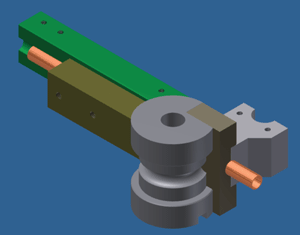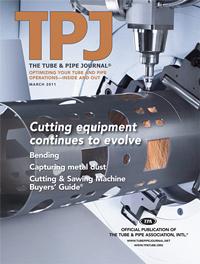- FMA
- The Fabricator
- FABTECH
- Canadian Metalworking
Categories
- Additive Manufacturing
- Aluminum Welding
- Arc Welding
- Assembly and Joining
- Automation and Robotics
- Bending and Forming
- Consumables
- Cutting and Weld Prep
- Electric Vehicles
- En Español
- Finishing
- Hydroforming
- Laser Cutting
- Laser Welding
- Machining
- Manufacturing Software
- Materials Handling
- Metals/Materials
- Oxyfuel Cutting
- Plasma Cutting
- Power Tools
- Punching and Other Holemaking
- Roll Forming
- Safety
- Sawing
- Shearing
- Shop Management
- Testing and Measuring
- Tube and Pipe Fabrication
- Tube and Pipe Production
- Waterjet Cutting
Industry Directory
Webcasts
Podcasts
FAB 40
Advertise
Subscribe
Account Login
Search
Ironing the wrinkles out of copper tubing
How a wiper die lowers the compressive forces during bending
- By George Winton
- March 10, 2011
- Article
- Tube and Pipe Fabrication
How a Wrinkle Forms
Simply put, as a tube transitions from a straight section to a bent section, it undergoes compressive stresses on the inside of the bend. When these compressive stresses exceed a certain limit, the inside wall may buckle. The result is a protrusion that forms away from the wiper die and toward the outside wall of the tube (because the material takes the path of least resistance). A wiper die is used to help offset or limit these compressive stresses in an attempt to make a wrinkle-free bend. So the question is, How exactly does a wiper die limit the compressive stresses when attempting a tight-radius bend?
First, in a way similar to how pinch tooling works to improve the outside appearance of a bent tube, a wiper die helps support a tube as the pressure die first makes contact with the tube. Second, once the pressure die is in contact with the tube, the wiper die continues to apply a force on the tube while the bending process is under way. Throughout the bending cycle, the wiper die is critical to supporting the intrados, or inside bend, of the tube.
Right before the tube experiences a bending torque, the wiper die goes to work, preventing the tube from separating from the pressure die. Figure 1 depicts a tube separating from the pressure die without the aid of a wiper die. This can be most obvious when bending a soft material such as 3003 aluminum or copper. The condition usually arises when the centerline bending radius approaches the tube's OD (1D bend).
If the tube heels away significantly from the pressure die before or during the bending motion, the tube may undergo an additional compressive stress component in the area surrounding the bend tangent. Thus, one goal of a wiper die is to ensure the tube stays aligned (parallel) with the pressure die as the tube is being drawn and bent.
The Bridge Support Concept
If you have a grip section in a bend die opposing the pressure die, and you have the wiper die on the other side of bend tangent also opposing the pressure die, then the pressure die is supported on both sides (see Figure 2).
A wiper die imparts force on the tube before and during the bending motion; this force counteracts the compressive forces within the tube induced by the bending process.
About the Author

George Winton
3644 Burnette Road
Suwanee, GA 30024
888-321-1499
About the Publication
subscribe now

The Tube and Pipe Journal became the first magazine dedicated to serving the metal tube and pipe industry in 1990. Today, it remains the only North American publication devoted to this industry, and it has become the most trusted source of information for tube and pipe professionals.
start your free subscription- Stay connected from anywhere

Easily access valuable industry resources now with full access to the digital edition of The Fabricator.

Easily access valuable industry resources now with full access to the digital edition of The Welder.

Easily access valuable industry resources now with full access to the digital edition of The Tube and Pipe Journal.
- Podcasting
- Podcast:
- The Fabricator Podcast
- Published:
- 04/16/2024
- Running Time:
- 63:29
In this episode of The Fabricator Podcast, Caleb Chamberlain, co-founder and CEO of OSH Cut, discusses his company’s...
- Trending Articles
Zekelman Industries to invest $120 million in Arkansas expansion

3D laser tube cutting system available in 3, 4, or 5 kW

Corrosion-inhibiting coating can be peeled off after use

Brushless copper tubing cutter adjusts to ODs up to 2-1/8 in.

HGG Profiling Equipment names area sales manager

- Industry Events
16th Annual Safety Conference
- April 30 - May 1, 2024
- Elgin,
Pipe and Tube Conference
- May 21 - 22, 2024
- Omaha, NE
World-Class Roll Forming Workshop
- June 5 - 6, 2024
- Louisville, KY
Advanced Laser Application Workshop
- June 25 - 27, 2024
- Novi, MI



























